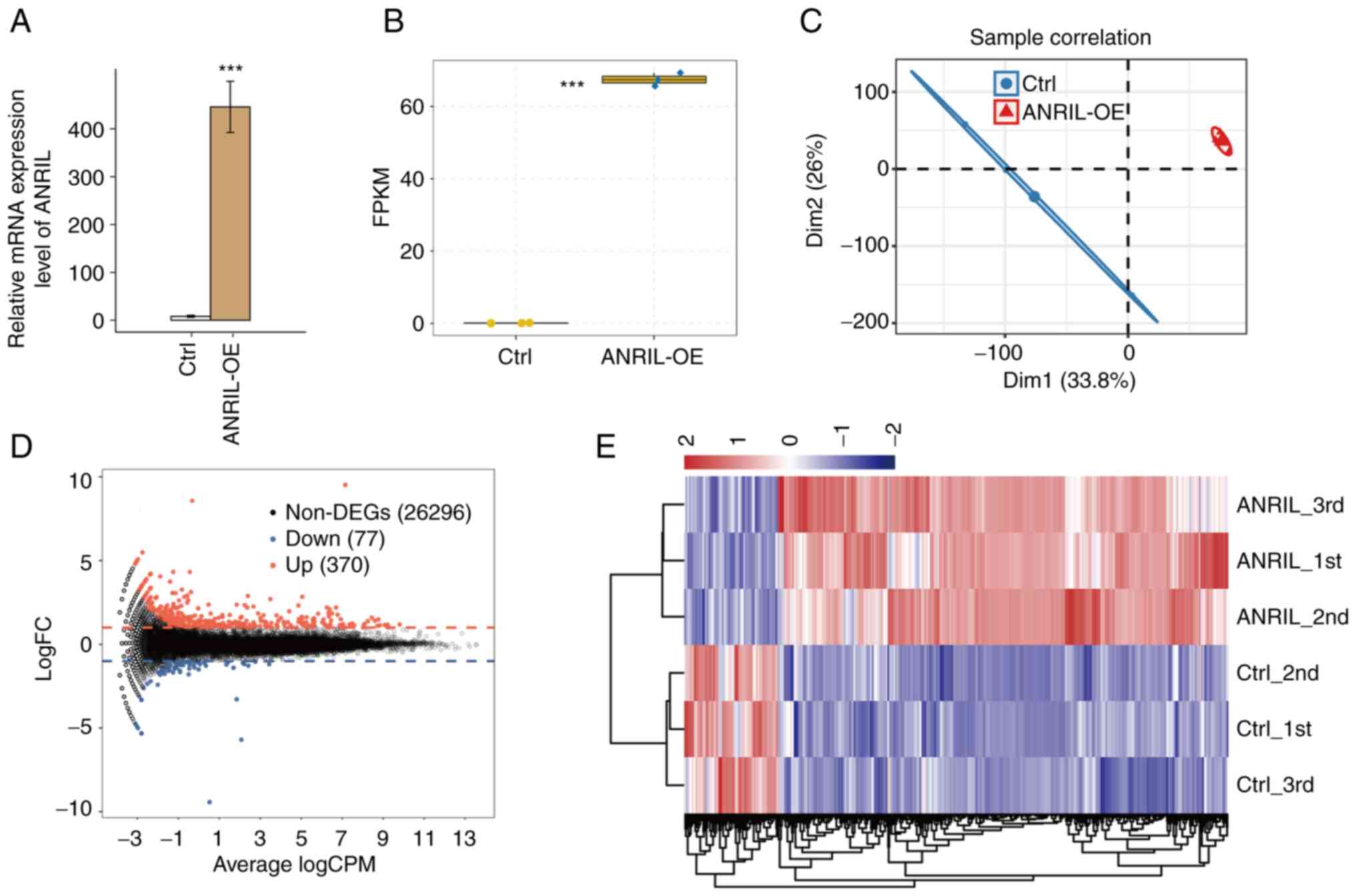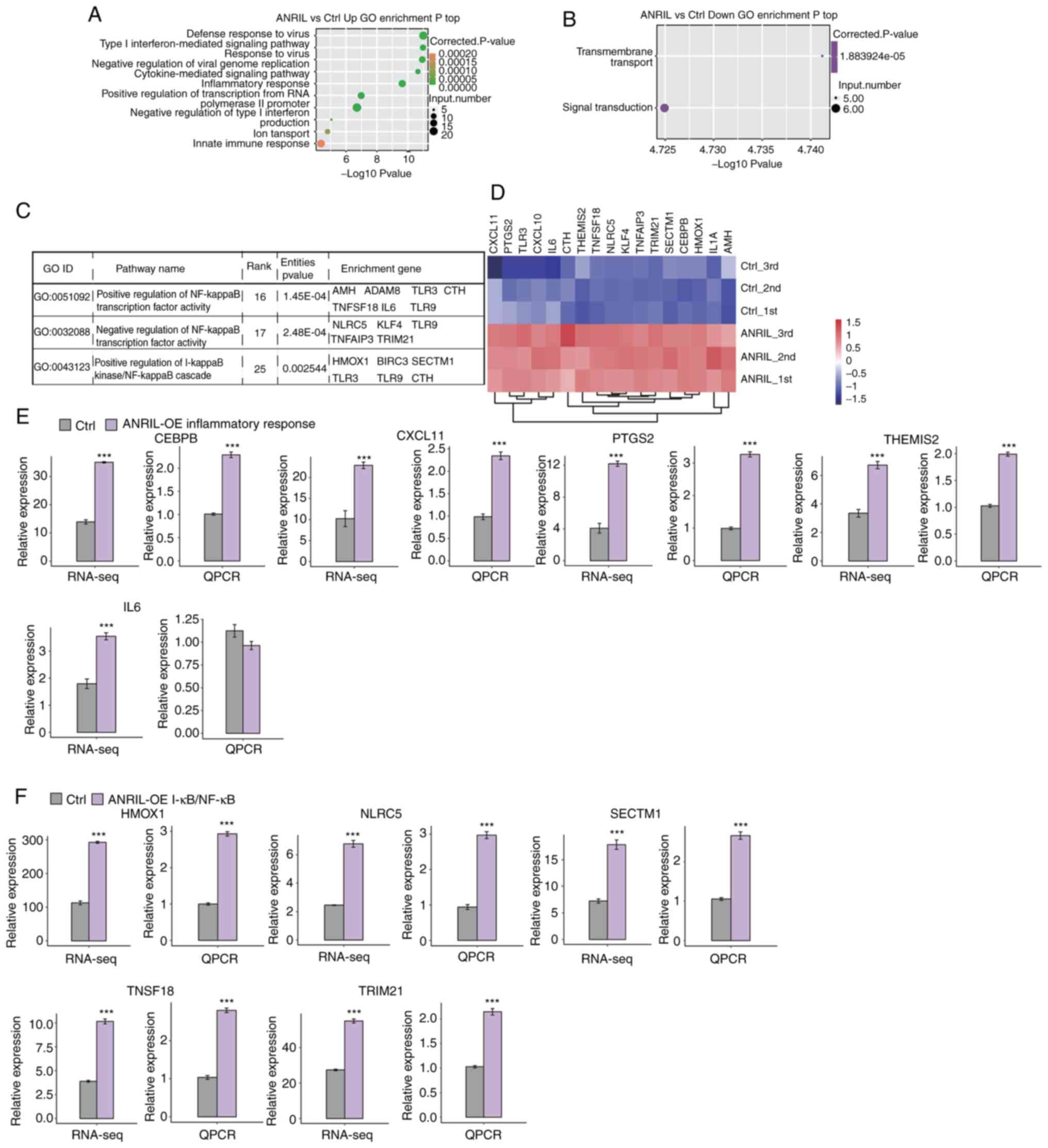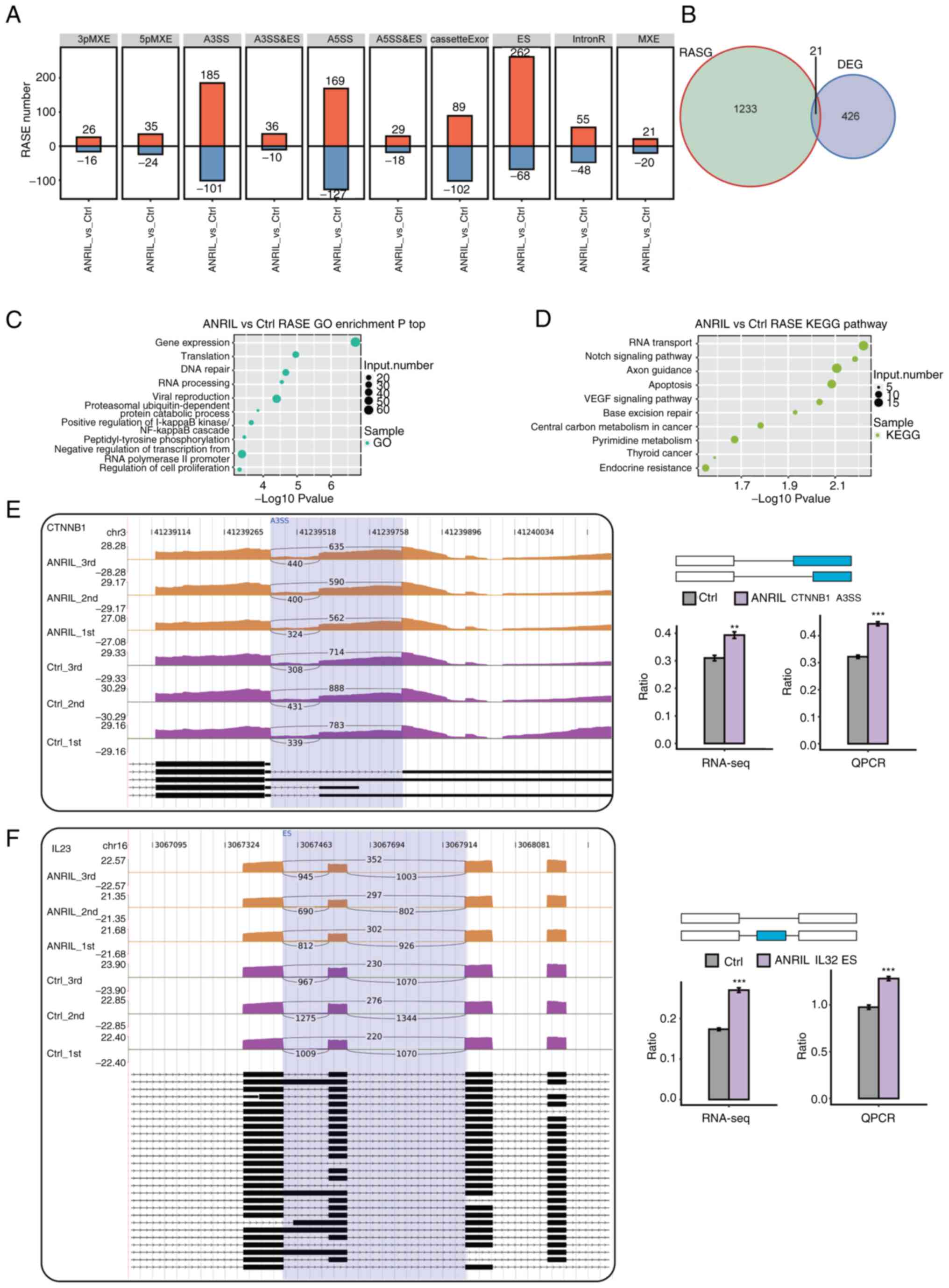|
1
|
Ren W and Yang X: Pathophysiology of long
non-coding RNAs in ischemic stroke. Front Mol Neurosci. 11:962018.
View Article : Google Scholar : PubMed/NCBI
|
|
2
|
Grammatikakis I and Lal A: Significance of
lncRNA abundance to function. Mamm Genome. 33:271–280. 2021.
View Article : Google Scholar : PubMed/NCBI
|
|
3
|
Lorenzen JM and Thum T: Long noncoding
RNAs in kidney and cardiovascular diseases. Nat Rev Nephrol.
12:360–373. 2016. View Article : Google Scholar : PubMed/NCBI
|
|
4
|
Statello L, Guo CJ, Chen LL and Huarte M:
Gene regulation by long non-coding RNAs and its biological
functions. Nat Rev Mol Cell Biol. 22:96–118. 2021. View Article : Google Scholar : PubMed/NCBI
|
|
5
|
Chen S, Wu Y, Qin X, Wen P, Liu J and Yang
M: Global gene expression analysis using RNA-seq reveals the new
roles of panax notoginseng saponins in ischemic cardiomyocytes. J
Ethnopharmacol. 268:1136392021. View Article : Google Scholar : PubMed/NCBI
|
|
6
|
Bao MH, Szeto V, Yang BB, Zhu SZ, Sun HS
and Feng ZP: Long non-coding RNAs in ischemic stroke. Cell Death
Dis. 9:2812018. View Article : Google Scholar : PubMed/NCBI
|
|
7
|
Folkersen L, Kyriakou T, Goel A, Peden J,
Mälarstig A, Paulsson-Berne G, Hamsten A, Watkins H,
Franco-Cereceda A, Gabrielsen A, et al: Relationship between CAD
risk genotype in the chromosome 9p21 locus and gene expression.
Identification of eight new ANRIL splice variants. PLoS One.
4:e76772009. View Article : Google Scholar : PubMed/NCBI
|
|
8
|
Chen W, Bharati S, Yi L, Benowitz L, Chen
Q, Zhang Z, Patel NJ, Aziz-Sultan AM, Chiocca AE and Wang X:
Monogenic, polygenic, and microRNA markers for ischemic stroke. Mol
Neurobiol. 56:1330–1343. 2019. View Article : Google Scholar : PubMed/NCBI
|
|
9
|
Amouyel P: From genes to stroke subtypes.
Lancet Neurol. 11:931–933. 2012. View Article : Google Scholar : PubMed/NCBI
|
|
10
|
Bai N, Liu W, Xiang T, Zhou Q, Pu J, Zhao
J, Luo D, Liu X and Liu H: Genetic association of ANRIL with
susceptibility to Ischemic stroke: A comprehensive meta-analysis.
PLoS One. 17:e02634592022. View Article : Google Scholar : PubMed/NCBI
|
|
11
|
Sun R, Wang L, Guan C, Cao W and Tian B:
Carotid atherosclerotic plaque features in patients with acute
ischemic stroke. World Neurosurg. 112:e223–e228. 2018. View Article : Google Scholar : PubMed/NCBI
|
|
12
|
Zhang L, Luo X, Chen F, Yuan W, Xiao X,
Zhang X, Dong Y, Zhang Y and Liu Y: LncRNA SNHG1 regulates
cerebrovascular pathologies as a competing endogenous RNA through
HIF-1α/VEGF signaling in ischemic stroke. J Cell Biochem.
119:5460–5472. 2018. View Article : Google Scholar : PubMed/NCBI
|
|
13
|
Mo Y, Sun YY and Liu KY: Autophagy and
inflammation in ischemic stroke. Neural Regen Res. 15:1388–1396.
2020. View Article : Google Scholar : PubMed/NCBI
|
|
14
|
Zhong W, Li YC, Huang QY and Tang XQ:
lncRNA ANRIL ameliorates oxygen and glucose deprivation (OGD)
induced injury in neuron cells via miR-199a-5p/CAV-1 axis.
Neurochem Res. 45:772–782. 2020. View Article : Google Scholar : PubMed/NCBI
|
|
15
|
Fang X, Hu J and Zhou H: Knock-down of
long non-coding RNA ANRIL suppresses mouse mesangial cell
proliferation, fibrosis, inflammation via regulating Wnt/β-Catenin
and MEK/ERK pathways in diabetic nephropathy. Exp Clin Endocrinol
Diabetes. 130:30–36. 2022. View Article : Google Scholar : PubMed/NCBI
|
|
16
|
Liu B, Cao W and Xue J: LncRNA ANRIL
protects against oxygen and glucose deprivation (OGD)-induced
injury in PC-12 cells: Potential role in ischaemic stroke. Artif
Cells Nanomed Biotechnol. 47:1384–1395. 2019. View Article : Google Scholar : PubMed/NCBI
|
|
17
|
Zhao JH, Wang B, Wang XH, Wang JR and Xu
CW: Influence of lncRNA ANRIL on neuronal apoptosis in rats with
cerebral infarction by regulating the NF-κB signaling pathway. Eur
Rev Med Pharmacol Sci. 23:10092–10100. 2019.PubMed/NCBI
|
|
18
|
Zhang B, Wang D, Ji TF, Shi L and Yu JL:
Overexpression of lncRNA ANRIL up-regulates VEGF expression and
promotes angiogenesis of diabetes mellitus combined with cerebral
infarction by activating NF-κB signaling pathway in a rat model.
Oncotarget. 8:17347–17359. 2017. View Article : Google Scholar : PubMed/NCBI
|
|
19
|
Livak KJ and Schmittgen TD: Analysis of
relative gene expression data using real-time quantitative PCR and
the 2(−Delta Delta C(T)) method. Methods. 25:402–408. 2001.
View Article : Google Scholar : PubMed/NCBI
|
|
20
|
Kim D, Pertea C, Trapnell H, Pimentel R,
Kelley R and Salzberg SL: TopHat2: Accurate alignment of
transcriptomes in the presence of insertions, deletions and gene
fusions. Genome Biol. 14:R362013. View Article : Google Scholar : PubMed/NCBI
|
|
21
|
Trapnell CBA, Williams G, Pertea A,
Mortazavi G, Kwan MJ, van Baren SL, Salzberg SL, Wold BJ and
Pachter L: Transcript assembly and quantification by RNA-Seq
reveals unannotated transcripts and isoform switching during cell
differentiation. Nat Biotechnol. 28:511–515. 2010. View Article : Google Scholar : PubMed/NCBI
|
|
22
|
Robinson MD, McCarthy DJ and Smyth GK:
edgeR: A Bioconductor package for differential expression analysis
of digital gene expression data. Bioinformatics. 26:139–140. 2010.
View Article : Google Scholar : PubMed/NCBI
|
|
23
|
Xie CX, Mao J, Huang Y, Ding J, Wu S, Dong
L, Kong G, Gao C, Li CY and Wei L: KOBAS 2.0: A web server for
annotation and identification of enriched pathways and diseases.
Nucleic Acids Res. 39:(Web Server issue). W316–W322. 2011.
View Article : Google Scholar : PubMed/NCBI
|
|
24
|
Xia H, Chen D, Wu Q, Wu G, Zhou Y, Zhang Y
and Zhang L: CELF1 preferentially binds to exon-intron boundary and
regulates alternative splicing in HeLa cells. Biochim Biophys Acta
Gene Regul Mech. 1860:911–921. 2017. View Article : Google Scholar : PubMed/NCBI
|
|
25
|
Jin L, Li G, Yu D, Huang W, Cheng C, Liao
S, Wu Q and Zhang Y: Transcriptome analysis reveals the complexity
of alternative splicing regulation in the fungus Verticillium
dahliae. BMC Genomics. 18:1302017. View Article : Google Scholar : PubMed/NCBI
|
|
26
|
Liu HW, Hu ZL, Li H, Tan QF, Tong J and
Zhang YQ: Knockdown of lncRNA ANRIL suppresses the production of
inflammatory cytokines and mucin 5AC in nasal epithelial cells via
the miR-15a-5p/JAK2 axis. Mol Med Rep. 23:1452021. View Article : Google Scholar : PubMed/NCBI
|
|
27
|
Zhou B, Li L, Qiu X, Wu J, Xu L and Shao
W: Long non-coding RNA ANRIL knockdown suppresses apoptosis and
pro-inflammatory cytokines while enhancing neurite outgrowth via
binding microRNA-125a in a cellular model of Alzheimer's disease.
Mol Med Rep. 22:1489–1497. 2020. View Article : Google Scholar : PubMed/NCBI
|
|
28
|
Feng L, Guo J and Ai F: Circulating long
noncoding RNA ANRIL downregulation correlates with increased risk,
higher disease severity and elevated pro-inflammatory cytokines in
patients with acute ischemic stroke. J Clin Lab Anal.
33:e226292019. View Article : Google Scholar : PubMed/NCBI
|
|
29
|
Holdt LM, Stahringer A, Sass K, Pichler G,
Kulak NA, Wilfert W, Kohlmaier A, Herbst A, Northoff BH, Nicolaou
A, et al: Circular non-coding RNA ANRIL modulates ribosomal RNA
maturation and atherosclerosis in humans. Nat Commun. 7:124292016.
View Article : Google Scholar : PubMed/NCBI
|
|
30
|
Zhang X, Tang X, Liu K, Hamblin MH and Yin
KJ: Long noncoding RNA Malat1 regulates cerebrovascular pathologies
in ischemic stroke. J Neurosci. 37:1797–1806. 2017. View Article : Google Scholar : PubMed/NCBI
|
|
31
|
Ruan Z, Wang S, Yu W and Deng F: LncRNA
MALAT1 aggravates inflammation response through regulating PTGS2 by
targeting miR-26b in myocardial ischemia-reperfusion injury. Int J
Cardiol. 288:1222019. View Article : Google Scholar : PubMed/NCBI
|
|
32
|
Liu Z, Liu J, Wei Y, Xu J, Wang Z, Wang P,
Sun H, Song Z and Liu Q: LncRNA MALAT1 prevents the protective
effects of miR125b5p against acute myocardial infarction through
positive regulation of NLRC5. Exp Ther Med. 19:990–998.
2020.PubMed/NCBI
|
|
33
|
Wu H, Liu B, Chen Z, Li G and Zhang Z:
MSC-induced lncRNA HCP5 drove fatty acid oxidation through
miR-3619-5p/AMPK/PGC1α/CEBPB axis to promote stemness and
chemo-resistance of gastric cancer. Cell Death Dis. 11:2332020.
View Article : Google Scholar : PubMed/NCBI
|
|
34
|
Jiang L and Li J: lncRNA GMDS-AS1
upregulates IL-6, TNF-α and IL-1β, and induces apoptosis in human
monocytic THP-1 cells via miR-96-5p/caspase 2 signaling. Mol Med
Rep. 25:672022. View Article : Google Scholar : PubMed/NCBI
|
|
35
|
Liu X, Li S, Yang Y, Sun Y, Yang Q, Gu N,
Li J, Huang T, Liu Y, Dong H, et al: The lncRNA ANRIL regulates
endothelial dysfunction by targeting the let/TGF-βR1signalling
pathway. J Cell Physiol. 236:2058–2069. 2020. View Article : Google Scholar : PubMed/NCBI
|
|
36
|
Huang T, Zhao HY, Zhang XB, Gao XL, Peng
WP, Zhou Y, Zhao WH and Yang HF: LncRNA ANRIL regulates cell
proliferation and migration via sponging miR-339-5p and regulating
FRS2 expression in atherosclerosis. J Eur Rev Med Pharmacol Sci.
24:1956–1969. 2020.PubMed/NCBI
|
|
37
|
Ying Liu X, Li S, Yang Y, Sun Y, Yang Q,
Gu N, Li J, Huang T, Liu Y, Dong H, et al: The lncRNA ANRIL
regulates endothelial dysfunction by targeting the let-7b/TGF-βR1
signalling pathway. J Cell Physiol. 236:2058–2069. 2021. View Article : Google Scholar : PubMed/NCBI
|
|
38
|
Bai Y, Nie S, Jiang G, Zhou Y, Zhou M,
Zhao Y, Li S, Wang F, Lv Q, Huang Y, et al: Regulation of CARD8
expression by ANRIL and association of CARD8 single nucleotide
polymorphism rs2043211 (p.C10X) with ischemic stroke. Stroke.
45:383–388. 2014. View Article : Google Scholar : PubMed/NCBI
|
|
39
|
Zhu X, Du J, Yu J, Guo R, Feng Y, Qiao L,
Xu Z, Yang F, Zhong G, Liu F, et al: LncRNA NKILA regulates
endothelium inflammation by controlling a NF-κB/KLF4 positive
feedback loop. J Mol Cell Cardiol. 126:60–69. 2019. View Article : Google Scholar : PubMed/NCBI
|
|
40
|
Zhang P, Yu C, Yu J, Yu J, Li Z, Lan HY
and Zhou Q: Arid2-IR promotes NF-κB-mediated renal inflammation by
targeting NLRC5 transcription. Cell Mol Life Sci. 78:2387–2404.
2020. View Article : Google Scholar : PubMed/NCBI
|
|
41
|
Suñé-Pou M, Prieto-Sánchez S,
Boyero-Corral S, Moreno-Castro C, El Yousfifi Y, Suñé-Negre JM,
Hernández-Munain C and Suñé C: Targeting splicing in the treatment
of human disease. Genes (Basel). 8:872017. View Article : Google Scholar : PubMed/NCBI
|
|
42
|
Huang JG, Sachdeva M, Xu E, Robinson TJ,
Luo L, Ma Y, Williams NT, Lopez O, Cervia LD, Yuan F, et al: The
long noncoding RNA NEAT1 promotes sarcoma metastasis by regulating
RNA splicing pathways. Mol Cancer Res. 18:1534–1544. 2020.
View Article : Google Scholar : PubMed/NCBI
|
|
43
|
Liu J, Chen Y, Liu D, Liu W, Hu S, Zhou N
and Xie Y: Ectopic expression of SIGIRR in the colon ameliorates
colitis in mice by downregulating TLR4/NF-κB overactivation.
Immunol Lett. 183:52–61. 2017. View Article : Google Scholar : PubMed/NCBI
|
|
44
|
Gupta KD, Shakespear MR, Curson JEB,
Murthy AMV, Iyer A, Hodson MP, Ramnath D, Tillu VA, von Pein JB,
Reid RC, et al: Class IIa histone deacetylases drive toll-like
receptor-inducible glycolysis and macrophage inflammatory responses
via pyruvate kinase M2. Cell Rep. 30:2712–2728. 2020. View Article : Google Scholar : PubMed/NCBI
|
|
45
|
Nelson WJ and Nusse R: Convergence of Wnt,
beta-catenin, and cadherin pathways. Science. 303:1483–1487. 2004.
View Article : Google Scholar : PubMed/NCBI
|
|
46
|
Moon-Sung L, Hee-Jung B, Lee J, Jeoung DI,
Kim YM and Lee H: Tetraspanin CD82 represses Sp1-mediated Snail
expression and the resultant E-cadherin expression interrupts
nuclear signaling of β-catenin by increasing its membrane
localization. J Cell Signal. 52:83–94. 2018. View Article : Google Scholar : PubMed/NCBI
|
|
47
|
Chai W, Liu R, Li F, Zhang Z and Lei B:
Long noncoding RNA TSLNC8 enhances pancreatic cancer aggressiveness
by regulating CTNNB1 expression via association with HuR. Hum Cell.
34:165–176. 2021. View Article : Google Scholar : PubMed/NCBI
|
|
48
|
Pan Z, Ding J, Yang Z, Li H, Ding H and
Chen Q: LncRNA FLVCR1-AS1 promotes proliferation, migration and
activates Wnt/β-catenin pathway through miR-381-3p/CTNNB1 axis in
breast cancer. Cancer Cell Int. 20:2142020. View Article : Google Scholar : PubMed/NCBI
|

















